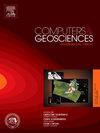Multimodal feature integration network for lithology identification from point cloud data
IF 4.2
2区 地球科学
Q1 COMPUTER SCIENCE, INTERDISCIPLINARY APPLICATIONS
引用次数: 0
Abstract
Accurate lithology identification from outcrop surfaces is crucial for interpreting geological 3D data. However, challenges arise due to factors such as severe weathering and vegetation coverage, which hinder achieving ideal identification results with both accuracy and efficiency. The integration of 3D point cloud technology and deep learning methodologies presents a promising solution to address these challenges. In this study, we propose a novel multimodal feature integration network designed to distinguish various rock types from point clouds. Our network incorporates a multimodal feature integration block equipped with multiple attention mechanisms to extract representative deep features, along with a hierarchical feature separation block to leverage these features for precise segmentation of points corresponding to different lithologies. Furthermore, we introduce a specialized loss function tailored for rock type identification to enhance network training. Through experiments involving point cloud sampling strategies and loss function evaluation, we identify the optimal network configuration. Comparative analyses against baseline methods demonstrate the superiority of our proposed network across diverse study areas reconstructed from UAV images and laser scanner data, exhibiting improved visual appearance and metric values (Accuracy = 0.978, mean Accuracy = 0.895, mean IoU = 0.857). These findings underscore the efficacy of the multimodal feature integration network as a promising approach for lithology identification tasks in various digital outcrop models derived from heterogeneous data sources.
从点云数据中识别岩性的多模态特征集成网络
从露头表面准确识别岩性对于解释地质三维数据至关重要。然而,由于严重风化和植被覆盖等因素,实现理想的识别结果的准确性和效率都受到了阻碍。三维点云技术与深度学习方法的结合为应对这些挑战提供了一种前景广阔的解决方案。在本研究中,我们提出了一种新型多模态特征集成网络,旨在从点云中区分各种岩石类型。我们的网络包含一个多模态特征集成块,配备多种注意机制以提取具有代表性的深度特征,以及一个分层特征分离块,利用这些特征精确分割对应不同岩性的点。此外,我们还为岩石类型识别引入了专门的损失函数,以加强网络训练。通过点云采样策略和损失函数评估实验,我们确定了最佳网络配置。与基线方法的对比分析表明,我们提出的网络在由无人机图像和激光扫描仪数据重建的不同研究区域中具有优势,显示出更好的视觉外观和度量值(准确度 = 0.978,平均准确度 = 0.895,平均 IoU = 0.857)。这些发现强调了多模态特征集成网络的功效,它是一种很有前途的方法,可用于从异构数据源获得的各种数字露头模型中的岩性识别任务。
本文章由计算机程序翻译,如有差异,请以英文原文为准。
求助全文
约1分钟内获得全文
求助全文
来源期刊

Computers & Geosciences
地学-地球科学综合
CiteScore
9.30
自引率
6.80%
发文量
164
审稿时长
3.4 months
期刊介绍:
Computers & Geosciences publishes high impact, original research at the interface between Computer Sciences and Geosciences. Publications should apply modern computer science paradigms, whether computational or informatics-based, to address problems in the geosciences.
 求助内容:
求助内容: 应助结果提醒方式:
应助结果提醒方式:


